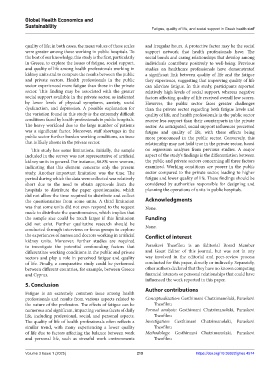Page 227 - GHES-3-1
P. 227
Global Health Economics and
Sustainability
Fatigue, quality of life, and social support in Greek health staff
quality of life; in both cases, the mean values of these scales and irregular hours. A protective factor may be the social
were greater among those working in public hospitals. To support network that health professionals have. The
the best of our knowledge, this study is the first, particularly social bonds and caring relationships that develop among
in Greece, to explore the issues of fatigue, social support, individuals contribute positively to well-being. Previous
and quality of life among health professionals working in studies on healthcare professionals have demonstrated
kidney units and to compare the results between the public a significant link between quality of life and the fatigue
and private sectors. Health professionals in the public they experience, suggesting that improving quality of life
sector experienced more fatigue than those in the private can alleviate fatigue. In this study, participants reported
sector. This finding may be associated with the greater relatively high levels of social support, whereas negative
social support available in the private sector, as indicated factors affecting quality of life received overall low scores.
by lower levels of physical symptoms, anxiety, social However, the public sector faces greater challenges
dysfunction, and depression. A possible explanation for than the private sector regarding both fatigue levels and
the variation found in this study is the extremely difficult quality of life, and health professionals in the public sector
conditions faced by health professionals in public hospitals. receive less support than their counterparts in the private
The heavy workload due to the large number of patients sector. As anticipated, social support influences perceived
was a significant factor. Moreover, staff shortages in the fatigue and quality of life, with these effects being
public sector further burden working conditions, an issue more pronounced in the public sector. Conversely, this
that is likely absent in the private sector. relationship may not hold true in the private sector, based
This study has some limitations. Initially, the sample on regression analyses from previous studies. A major
included in the survey was not representative of artificial aspect of the study’s findings is the differentiation between
kidney units in general. For instance, 86.8% were women, the public and private sectors concerning all three factors
indicating that this element concerns only the present examined. Working conditions are poorer in the public
study. Another important limitation was the time. The sector compared to the private sector, leading to higher
period during which the data were collected was relatively fatigue and lower quality of life. These findings should be
short due to the need to obtain approvals from the considered by authorities responsible for designing and
hospitals to distribute the paper questionnaire, which planning the operations of units in public hospitals.
did not allow the time required to distribute and collect
the questionnaires from some units. A third limitation Acknowledgments
was that some units did not even respond to the request None.
made to distribute the questionnaires, which implies that
the sample size could be much larger if this limitation Funding
did not exist. Further qualitative research should be None.
conducted through interviews or focus groups to explore
the experiences of nurses and doctors working in artificial Conflict of interest
kidney units. Moreover, further studies are required
to investigate the potential confounding factors that Paraskevi Theofilou is an Editorial Board Member
differentiate working conditions in the public and private and Guest Editor of this journal, but was not in any
sectors and play a role in perceived fatigue and quality way involved in the editorial and peer-review process
of life. Finally, a comparative study could be performed conducted for this paper, directly or indirectly. Separately,
between different countries, for example, between Greece other authors declared that they have no known competing
and Cyprus. financial interests or personal relationships that could have
influenced the work reported in this paper.
5. Conclusion
Author contributions
Fatigue is an extremely common issue among health
professionals and results from various aspects related to Conceptualization: Gesthimani Chatzimanolaki, Paraskevi
the nature of the profession. The effects of fatigue can be Theofilou
numerous and significant, impacting various facets of daily Formal analysis: Gesthimani Chatzimanolaki, Paraskevi
life, including professional, social, and personal aspects. Theofilou
The quality of life of health professionals often reflects a Investigation: Gesthimani Chatzimanolaki, Paraskevi
similar trend, with many experiencing a lower quality Theofilou
of life due to factors affecting the balance between work Methodology: Gesthimani Chatzimanolaki, Paraskevi
and personal life, such as stressful work environments Theofilou
Volume 3 Issue 1 (2025) 219 https://doi.org/10.36922/ghes.4574

